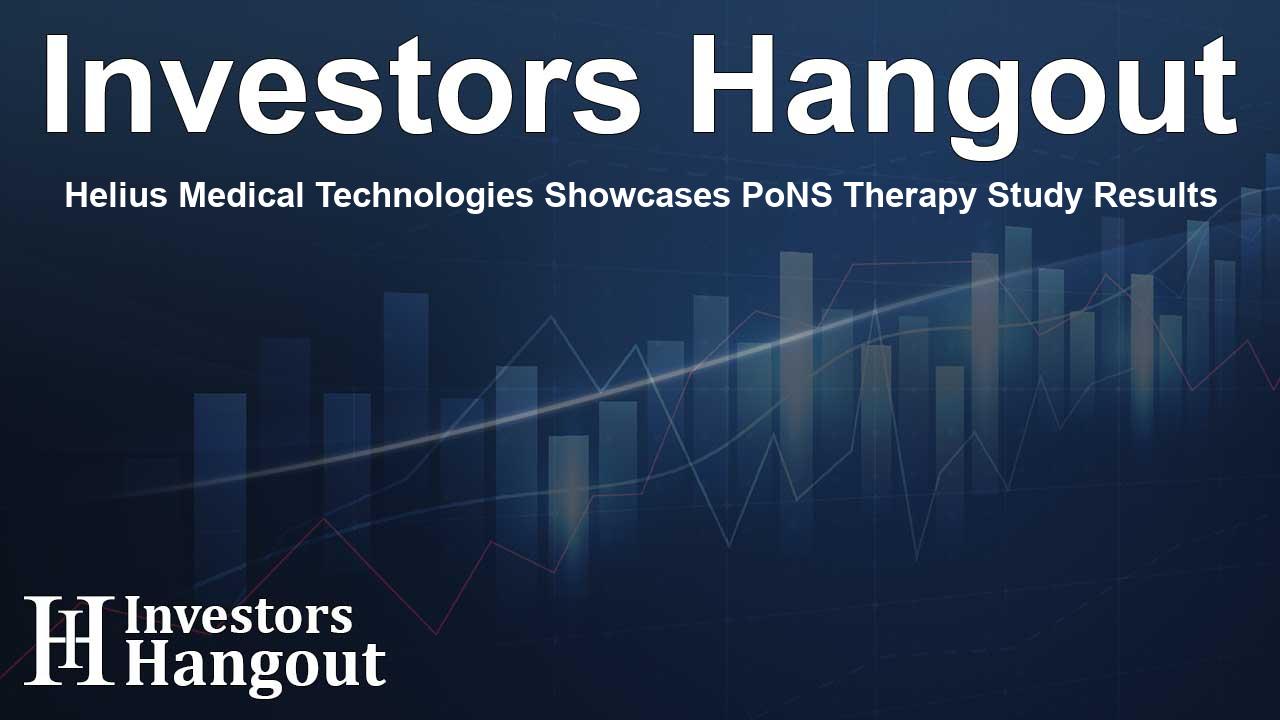Helius Medical Technologies Showcases PoNS Therapy Study Results

Exciting Developments in Gait Therapy for MS Patients
Helius Medical Technologies, Inc. (NASDAQ: HSDT), a pioneering neurotech company, is thrilled to unveil important findings concerning its Portable Neuromodulation Stimulator (PoNS). This innovative device addresses balance and gait challenges faced by those with multiple sclerosis (MS). The revelations will be presented at the Consortium of Multiple Sclerosis Centers (CMSC) Annual Meeting, taking place between May 28 and May 31 at the Phoenix Convention Center.
Unveiling Findings from the PoNS Therapeutic Experience Program
Dr. Deborah Backus, the Vice President of Research and Innovation at a leading rehabilitation center, will showcase the study results during a platform presentation on May 29. This marks a significant moment as it’s the first presentation of the full study results, which highlight the effectiveness of PoNS Therapy in enhancing the mobility of MS patients.
The Importance of Adherence to PoNS Therapy
In the innovative PoNSTEP study, data revealed a crucial connection between adherence to the PoNS regimen and improvement in mobility. Dr. Backus indicated that the data shows not just anecdotal benefits; there’s a statistically significant correlation between sticking to the PoNS treatment plan and improvements in walking ability. This is particularly impactful for individuals with MS who often see few options for effective treatment of their gait deficits.
Study Design and Patient Outcomes
The design of the PoNSTEP study engaged participants through a structured three-phase approach. Initially, patients underwent two weeks of in-clinic therapy, followed by 12 weeks of therapy that integrated both clinic visits and home use. The study concluded with a six-month follow-up to assess the longevity of the improvements achieved.
A key finding from PoNSTEP is the positive effect of commitment to the therapy. Participants who adhered to the therapy—utilizing the device for the recommended 100–120 minutes a day—saw substantial improvements in their Dynamic Gait Index (DGI) scores, indicating better walking function and balance. The most committed individuals achieved gains exceeding six points in their scores, demonstrating a direct relationship between adherence and therapy outcomes.
Durability of Treatment Effects
The long-term benefits of PoNS Therapy were made evident through follow-up evaluations. Over 95% of participants maintained their improvement levels six months post-treatment. This highlights the treatment's potential to not only provide immediate benefits but also sustainable improvements in gait and balance for MS patients.
Significance in Neuromodulation and Rehabilitation
Dr. Favit-Van Pelt, the Chief Medical Officer, emphasized the importance of these findings for the MS community. The study adds to the growing body of evidence that showcases the capabilities of neuromodulation therapies in rehabilitating neural networks and enhancing neuroplasticity, which are critical in treating conditions like MS. With the challenges many patients face regarding mobility, the ability offered by PoNS therapy to drive measurable improvements comes as a beacon of hope.
This therapy is gaining traction, with insurance providers, including the U.S. Department of Veterans Affairs and the Department of Defense, beginning to reimburse for PoNS treatment, marking an essential step toward broader accessibility for affected individuals.
About Helius Medical Technologies
Helius Medical Technologies is leading the charge in the neurotech industry with their specialized oral device designed to stimulate the brain’s natural healing processes. Their flagship product, the Portable Neuromodulation Stimulator, plays a pivotal role in aiding those suffering from neurologic deficits. The company remains dedicated to advancing treatment options that significantly improve patients' quality of life regarding their neurological needs.
Frequently Asked Questions
What is PoNS therapy?
PoNS therapy utilizes a non-implantable device that provides neurostimulation to improve balance and gait in patients with conditions like multiple sclerosis.
How was the PoNSTEP study structured?
The PoNSTEP study involved three phases: two weeks of in-clinic therapy, 12 weeks of combined clinic and home use, followed by a six-month follow-up.
What were the key findings from the PoNSTEP study?
The study found a significant relationship between adherence to PoNS therapy and improved gait function, with lasting effects noted six months post-treatment.
Who presented the study results at the CMSC Annual Meeting?
Dr. Deborah Backus will present the study findings, highlighting their impact on enhancing mobility for MS patients.
What is the significance of this study for MS patients?
This study confirms the therapeutic potential of PoNS Therapy, providing a viable treatment choice for improving mobility in individuals with MS.
About The Author
Contact Addison Perry privately here. Or send an email with ATTN: Addison Perry as the subject to contact@investorshangout.com.
About Investors Hangout
Investors Hangout is a leading online stock forum for financial discussion and learning, offering a wide range of free tools and resources. It draws in traders of all levels, who exchange market knowledge, investigate trading tactics, and keep an eye on industry developments in real time. Featuring financial articles, stock message boards, quotes, charts, company profiles, and live news updates. Through cooperative learning and a wealth of informational resources, it helps users from novices creating their first portfolios to experts honing their techniques. Join Investors Hangout today: https://investorshangout.com/
The content of this article is based on factual, publicly available information and does not represent legal, financial, or investment advice. Investors Hangout does not offer financial advice, and the author is not a licensed financial advisor. Consult a qualified advisor before making any financial or investment decisions based on this article. This article should not be considered advice to purchase, sell, or hold any securities or other investments. If any of the material provided here is inaccurate, please contact us for corrections.
